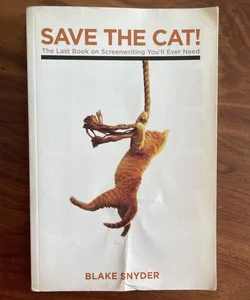The Truth About Screenwriting Books
Hey folks,
Today I want to talk about the elephant in the room...
Actually, I want to talk about the cat on the rope.

If you talk to anyone in the film industry who deals with scripts, eventually, this book will get mentioned.
What is Save The Cat?
It’s a book with "the formula” for writing great Hollywood films.
There are other well-known books & theories like it (most notably Story by Robert McKee & Screenplay by Syd Field), but Save The Cat gets brought up the most, I’d argue for one reason…
It’s really, really simple.
I mean, there’s a cat on the cover, how hard could this stuff be?
And by breaking down storytelling principles into simple, intuitive expressions like the title (which refers to getting the audience to love a character by making the character do something benevolent like save a cat), it’s easy to start dropping those expressions into conversation and getting other writers and producers to nod their heads.
However, when it comes to independent filmmakers like us, and even the writers of Hollywood blockbusters, these books & formulas create just as many problems as solutions.
So let’s Dropkick The Cat and dive in.

(Whoops, did this make me harder to root for?)
Writing With No Formula
When my writing partner and I first started making short films, we knew nothing about structure outside of the very basic idea of Act I, Act II, and Act III (beginning, middle, and end).
Usually it worked out fine, but short films are different from features.
It’s much easier to instinctively structure a short that works, because the stories are so simple. The hard part with writing a short film is keeping it simple, and making that simplicity work elegantly and powerfully.
But when writing a feature film, it’s much harder to wing it structurally.
There’s so much runtime, so many themes, characters, and subplots to cover - how do you balance everything? And how do you make sure the audience stays engaged the whole time?
Structure give you the freedom to be truly creative in a feature film. If you’re confident in your story’s structure, you're free to take bigger swings moment to moment within that structure.
However, if you’re just throwing cool ideas against the wall and haphazardly connecting the dots, the end product is going to be an uneven slog. The best individual scenes can’t make up for a messy overall flow in a feature. The whole of an excellent feature is truly always greater than the sum of its parts.
But Save The Cat is all about how to structure a feature film, so what’s the problem?
For me, the worst way someone could describe one of my films is “formulaic”.
And if you write with Save The Cat open beside you the whole time, you'll have a solid structure; however, you’re almost guaranteed to make a film that feels formulaic.
Screenplay Formulas: Pros & Cons
The best use of screenplay formulas & books like this are as case studies.
If you treat Save The Cat like “Here's a series of tools and an overall structure that worked well for these famous movies, and here’s why they worked” then you are likely to gain a ton of value from the book.
On the other hand, if you treat it as “Here is the way to write a good movie” then you are going to rob yourself of originality at every step of the writing process.
That's because I believe that structure itself requires creativity and a individual touch for each story. The structure is ultimately there to serve and strengthen the unique qualities of the story. The story is not there to serve a preset/template structure.
Also, Save The Cat itself was written by Blake Snyder. Never heard of him? That’s because he’s kind of a hack screenwriter. Snyder wrote a couple of 90’s kid movies, that’s it. To be fair, some of my childhood friends referred to his movie Blank Check as a classic (I never saw it).
So if the guy with all the answers can’t execute his own philosophy at a high level, then the ideas in his book probably shouldn’t be taken as dogma.
By the way, Blake Snyder is dead, and I’m a robust 34 year old, so even though I also probably haven’t executed my philosophies at the highest level… I’ve still got time. Just let me cook okay?

I believe the increase of formulaic filmmaking from this book (and from risk-averse mega-conglomerate studios regurgitating previous blockbusters), has led to a much blander film landscape than we had in the 90’s.
In fact, I think Save The Cat has probably done more harm than good overall.
I can only imagine the closed-door conversations between talented, veteran screenwriters actually attempting something bold on a studio script, only to get hemmed in by a studio exec demanding some “save the cat” moments just so he can seem knowledgable, put his stink on the film, and justify his job.
But with all that said, I think Save The Cat is required reading for novice filmmakers.
Here’s why.
Knowing The Rules
The best films will surprise the audience in some way.
You do that by subverting their expectations.
To know their expectations, you have to know the common formulas for these common film stories.
And to know the formulas, you need to read these books.
Once you know the “rules”, you have storytelling power in your hand. You have the power to follow, or subvert a rule. And if you break a rule, it’s not accidental. You know that you’re breaking it, and then it's up to you to figure out why it’s still going to work.
That’s why the best way to approach these writing formulas and books is to read them, learn them, and then put them away and forget about them. If you can get to a point where you know the ideas and rules intuitively, Save The Cat is more useful to you.
But if you start using it like a roadmap as you’re outlining and typing up your script, you’re likely to hem yourself into a story that doesn’t surprise your audience.
And even worse, you’re likely to start forcing your script to adhere to certain story beats and page count rules that are not actually real rules (despite the book trying to convince you that EVERY FILM works that way).
For every “rule” in Save The Cat, you can list tons of amazing films that don’t adhere to it at all. In reality, the rules in that book are merely tools you can use when appropriate.
But if you treat every page of the book like gospel, eventually you’ll find yourself doing the screenwriting equivalent of using a screwdriver to tie your shoes (and blaming yourself when it doesn’t work out). Really, you just didn't need that tool for that job.
So my advice is study it, think critically about the ideas, and then put it away before writing your next film.
My favorite things this week:
📚 Books: Still slogging through the audiobook of The Memoirs of Ulysses S. Grant. Grant writes assuming everyone knows the context of the battles, so I had to start pulling up maps of each battle online to even have a chance at following what's happening😂 Interesting stuff, but it's so dryly written I'll probably surrender reading before the end of the war. I'm also realizing Grant is never going to even mention the fact that he was a lifelong alcoholic, so I might switch over to Ron Chernow's Grant book for a less biased version.
📼 Movies: Primer. A classic in the world of micro-budget films. The writer/director/star Shane Carruth shot this time travel film on 16mm for $7k back in 2003. He came from an engineering background, and it shows in the authenticity of how the characters talk and create their time machine. Carruth refused to dumb-down the dialogue, in favor of realism. That choice, plus the mind-bending logic of the film, make it incredibly hard to follow. But still it was an engaging, fresh take on the time-travel genre, and a master-class in working with what you already have to make a standout film without spending a fortune.
This was my first time watching it since college, and I was even more lost, until I also watched this amazing 20+ minute YouTube video explaining what the hell happened lol.
By the way, I think it’s time to name this newsletter and make it official.
Most newsletters use alliteration with the day of the week they’re sent, so… Friday Film Notes?
Reply here if you have any better ideas!
Let’s make some movies.
-Kent
PS - No cats were harmed in the making of this newsletter.